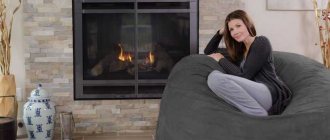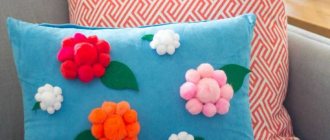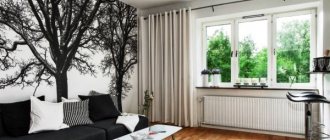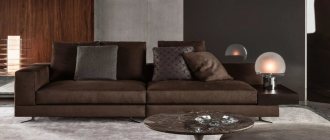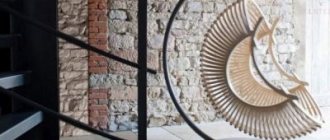How to sew a bean bag chair: patterns, fabric calculations, sewing tips.
Bean bag chairs in pictures and TV screens look bright and stylish, and therefore the idea of sewing a bean bag chair with your own hands is tempting. The technology for making such furniture itself is not very complicated, and below we will give several diagrams and step-by-step instructions that will help you sew a bean bag chair with your own hands. Now let's look at the possible nuances, features and subtleties associated with this piece of furniture.
Bean bag chair: who is it suitable for and how practical is it?
In designer interiors, bean bags are often found in recreation areas on balconies and terraces, in children's rooms and living rooms. In a word, in those places that suggest rest and relaxation. This is dictated by the features of this piece of furniture.
- The bean bag chairs are low and very soft, they take the shape of the body. In this chair you will be comfortable watching TV, sitting with a tablet in your hands, or chatting with friends on the balcony. But this chair will not be comfortable near a computer desk or in the dining area. Even near the dressing table it will not be very practical and low. That is, rest is his main purpose.
- Bean bags do not have sharp corners, are lightweight and therefore are well suited for children's rooms. They are often loved by cats and children. It is convenient for children to use them for purposes other than their intended purpose. For example, as a trampoline or as a mat on which it is convenient to jump from a sofa or wall bars.
- Bean bag chairs often become an “object of attraction” for house guests. They are unusual and can be very bright. Therefore, this is good furniture for the guest area.
Bean bag chair (pear)
To be fair, we need to list the difficulties that may arise during the operation of a bean bag chair.
- Bean bag chairs take up a lot of space and therefore are unlikely to be suitable for owners of one-room apartments.
- The filling of a bean bag chair inevitably gets compacted after just a couple of months. You need to be prepared for the fact that you will have to buy new foam granules, which are used to fill bean bags. It is also necessary to provide zippers on the outer and inner covers so that you can add filler.
- Some people don’t like the shapelessness and “buoyancy” of a bean bag chair, but this is a matter of taste.
Bean bags are not always stable
Manufacturing technology
If a beginner is doing the work, then it is advisable to initially try to make a simple product, for example, a bean bag chair, and after obtaining a high-quality result, you can try to make complex, unusual and original models.
How to make frameless furniture? The procedure is considered simple, but is implemented in successive stages, each of which has its own characteristics. First, materials for work are selected, after which the base is formed. Next, patterns are made or found and furniture covers are created. The internal element is filled with padding material, which will allow you to get a beautiful and original product.
Forming the Foundation
The simplest options use a round or oval base. If you have experience creating patterns, you can try to make more complex options. Although due to the soft filler, represented by balls of foam rubber, polystyrene foam or other materials, the products do not hold their shape, the furniture should still have a certain appearance. Due to the ability of furniture to follow the contours of the human body, such products are classified as orthopedic.
The shape of the products depends on the type of furniture chosen.
| Type of furniture | Her shape |
| Bag chair | It has a standard round or slightly elongated oval shape. This configuration is similar to standard products that are not equipped with armrests. |
| Pear chair | It has an oval shape and completely lacks corners or additional elements. |
| Cushion chair | It is presented as a small rectangle, so it does not take up much space. |
| Poof | Its shape can be a cylinder or a square. Such frameless furniture does not require much space and is convenient to use. |
| Ball | It is a round product with different sizes. |
| Pyramid | It has a corresponding triangular shape. The advantage of choosing such furniture is that it perfectly supports not only your back, but also your head. |
| Sofa | Consists of several modules with a rectangular shape. Due to the lack of a frame, they are connected only by fabric, and certain models can be transformed into a bed. |
Poof
Cushion chair Bean bag chair
Ball
Armchair
Sofa
Thus, you first need to choose the type of furniture, after which its shape and size are determined. The base is created using durable fabric, for which the following steps are performed:
- The furniture that will be formed with your own hands is determined;
- The material for the inner bag is selected;
- A drawing is constructed using suitable tools;
- Patterns are transferred to the selected material using chalk;
- All base elements are carefully cut out;
- They are sewn together using strong threads, leaving space for a zipper;
- A zipper is sewn in.
The resulting base is ready for filling with filler.
Choosing fabric
Making a drawing
Making patterns
Sew patterns
Sew in a zipper
Upholstery selection
Upholstery is used to create an outer cover. The most frequently selected fabrics are those that are characterized by high strength, density, and resistance to stains. They can easily withstand various impacts and last a long time. For the manufacture of frameless furniture, it is not advisable to choose silk, satin or calico, as they quickly lose their attractive appearance during use.
To create the inner cover, a fabric with high strength and density is selected; for the outer cover, decorative fabrics are used. To create the inner cover, a fabric with high strength and density is selected, but the appearance does not matter, so standard white material is usually purchased.
The most suitable materials for sewing frameless furniture are:
- Velor is a soft fleecy fabric, pleasant to the touch and pliable to use;
- Flock is ideal for furniture installed in a children's room. The material does not fade, is easy to clean and wash;
- Chenille is a natural fabric with the addition of synthetic fibers, so the material is highly durable and easy to care for;
- Jacquard is also formed using synthetic fibers and has good strength. It is easy to work with and easy to care for afterwards;
- Artificial leather – easy to care for, attractive in appearance and highly durable;
- Tapestry is a natural fabric in which the interweaving of fibers is easily visible, and to create it, threads of different colors are used, which intertwine to form beautiful patterns.
We sew the inner bag from any unnecessary but durable fabric in neutral shades, and the outer bag should not only be reliable and durable, but also stylish in appearance.
Chenille
Flock
Natural jacquard Faux leather
Tapestry
Velours
Pattern
Sewing bags requires patterns of frameless furniture, which can be made on paper yourself or downloaded from the Internet. Usually on different websites you can find photos of the furniture itself along with patterns. In this case, you can choose the optimal model, print out the diagrams, transfer the elements to the fabric and sew the bag.
If you plan to make patterns yourself, then this process is performed in sequential steps:
- It is determined what size the product will have;
- It is decided what parts it will consist of;
- Special tracing paper with 2.5 or 5 cm cells is prepared;
- All future furniture elements are marked on paper, and if a bean bag chair is created, then 4 sidewalls, 2 round parts and rectangular sections for the handle, if provided, are created;
- During work, you must use a ruler, pencil, compass and other writing instruments to ensure the evenness and correctness of the elements;
- Next, you need to make seam allowances to obtain patterns that differ in clearly matched cuts and the direction of the warp thread.
Once the necessary pattern for a specific frameless furniture has been prepared, the elements are transferred to the fabric. For this, special wax or regular chalk is used. It is advisable to make the bottom double to increase strength. Patterns are transferred with a small seam allowance of 1 to 1.5 cm, if the patterns are made without taking them into account. If you have difficulties creating patterns, you can contact the studio, where specialists will quickly cope with this task.
Determining the dimensions of the chair
We purchase tracing paper
Making elements of future furniture
We create patterns
How to sew
Once all the parts are prepared, you can start sewing. The master class for creating cases with your own hands consists of the following steps:
- Initially, the wedges are sewn together, for which they are folded with the front side inward and connected on one side, while it is important to leave an allowance of approximately 10 mm;
- The front side of the wedges is stitched;
- A zipper is sewn into the side of one side, and it is desirable that its length be at least 40 cm, as this will ensure ease of filling the bag with granules;
- At the top of the cover you need to sew Velcro to ensure that the cover inside will not wrinkle;
- The inner bag is filled with the selected granules;
- After creating this element, the production of the outer case begins, the same principle is used for this;
- The difference is a longer zipper (about a meter);
- Velcro is attached to the inside;
- The inner cover is inserted into the outer one, after which the Velcro is connected.
To strengthen the seams, you can overlock them or fold the allowances, after which a stitch is applied to them. Properly sewn frameless furniture will be beautiful and durable, and will also cope well with different loads.
Sewing the wedges
Sew in a zipper
Sew on Velcro
Fill the bag with granules
Making an outer case
Insert the outer cover into the inner one
What to fill with
Frameless products are distinguished by the absence of any solid objects; they are filled only with special granules. Fillers are usually sold by companies involved in insulating various structures.
The most popular are polystyrene granules, they are:
- They have a white color;
- They are environmentally friendly and therefore safe for people;
- Have water-repellent properties;
- Reasonable price.
For frameless furniture, it is advisable to choose small granules that are easily distributed in the bag. The required number of elements depends on the dimensions of the covers. Bags are filled 2/3 full.
In addition to polystyrene granules, you can use elements made from foam plastic, but they are quite fragile. Some people prefer to use down or feathers to fill their cases, but over time they get lost and can also cause allergic reactions.
Pattern of a bean bag chair, pear chair
To sew a bean bag chair with your own hands, you need to make an outer and inner cover.
The inner cover is very desirable, because we will fill the bean bag chair with polystyrene foam (balls from which foam is made), and this material very easily scatters around the room and is difficult to collect.
The outer and inner covers for the bean bag chair are sewn using the same pattern. Below we have created a pattern for a bean bag chair with a height of 130 cm, that is, one that would be comfortable for an adult to sit on.
Pattern of a bean bag chair, how to lay it out on fabric
Such a large bean bag chair will require quite a lot of fabric - a little less than 4 meters with a width of 140 cm. The same amount of fabric will be required for the inner cover. When choosing material for a beanbag chair, you can go in two ways:
- The first inexpensive option is Oxford fabric, which, however, has many variations. The material is similar to a thin, non-stretchy and waterproof raincoat fabric. The advantages of such fabric are that it is budget-friendly and that the material does not allow moisture to pass through well. Disadvantages - this fabric rustles and is not very pleasant to the touch.
- The second option is furniture fabrics. There are a huge number of them: flock, jacquard, matting, furniture artificial leather and others.
As for the inner cover, we categorically do not recommend using non-woven material for it, either non-woven or denser. Some manufacturers try to save money this way, but this fabric tears very easily and cannot withstand stress. What can I use for the inner cover? Cotton fabric, possibly mixed with synthetics, is suitable. How to cut the fabric to make a bean bag chair with your own hands can be seen in more detail in the diagram below. Each cell in the diagram is equal to 10 real centimeters.
Manufacturers of bean bags often equip them with eyelets. They are needed to relieve pressure on the seams when a person suddenly sits down on a chair. We believe that installing eyelets on a bean bag chair made by yourself is problematic, and there is a risk of severe damage to the fabric. Alternatively, you can simply leave holes in the seam between the top cover and the sides, about a centimeter in diameter.
DIY beanbag pattern.
The diagram is shown without seam allowances. We recommend adding another 2 cm to each piece. The threads should be strong and the seam should be double or linen.
Preparatory work
In order for the process of sewing a chair to go smoothly, it is necessary to carefully consider all the details of the future product. The first preparatory stage will be to find the desired shape of the chair and prepare a pattern. Having thought through these points, you can begin to select the material.
Features of the choice of material for the outer and inner covers
The inner case must be durable. The ideal choice would be teak, which is used for sewing pillows. This material has increased strength and wear resistance. To prevent the pattern of the inner cover from showing through, it is better to give preference to light, plain or white fabric.
White inner case
On a note! Knitted outer covers look very nice and cozy, but their wear resistance is insufficient. It is much more convenient to use synthetic fabrics that have water- and dirt-repellent properties.
Threads for sewing also need to be chosen of the appropriate thickness so that as a result of increased load the chair does not come apart at the seams. A metal zipper is ideal as a fastener. You will need 2 of them, 45 and 100 cm long, for the inner and outer covers.
Fastener on the chair
The material of the outer cover depends on the wishes of the owner of the house. If the chair will be used in the living room, then it is better to give preference to pastel colors. To equip children's rooms, you can safely use bright colors of fabrics or leatherettes. Here it is worth paying attention to the quality and composition of the fabric, which should be easy to clean and machine wash.
The best fabrics for frameless furniture
You will also need auxiliary materials:
- scissors;
- chalk;
- needles and threads;
- graph paper for making patterns;
- pins;
- ruler;
- sewing machine.
When all the materials for sewing the cover are ready, it’s time to think about purchasing high-quality filler.
Where to buy filler
You can use synthetic fibers, millet, buckwheat or rice seeds as a filler for the bag. Down, horsehair, and animal hair are also used. Some manufacturers stuff bean bags with wood shavings. All these materials are suitable as fillers for frameless furniture, but their wear resistance is very low. The fact is that organic materials are very sensitive to moisture and dampness. In addition, dust mites can parasitize in such fillers, and allergy sufferers may experience an exacerbation.
It is much more convenient and practical to use synthetic material - granulated polystyrene foam (foam balls) for filling bean bags and other frameless furniture. They can be purchased at any hardware store.
Filler for bean bag chair
A high-quality filler has the following qualities:
- high wear resistance (up to 50-70 years);
- thermal insulation;
- hypoallergenic;
- lightness, because 98% of the balls consist of air;
- wide temperature range of use;
- moisture resistance.
In addition to the above advantages, the material has an affordable price, which significantly reduces the cost of frameless furniture. Granulated polystyrene foam is sold packaged in special bags. The diameter of the granules is 3-6 mm. To fill one medium-sized chair you will need 300-500 liters of filler.
Dimensions of frameless furniture
Step-by-step instructions for making a bean bag chair
Below are standard instructions for making a medium sized bean bag chair.
Step 1. Spread the fabric for the inner cover on the floor or other flat surface with the right side facing inward. We fold the fabric crosswise, so that there is an edge along the edges, a fold in front, and cut edges behind.
Fabric for the cover
Step 2. Cut off the compacted edge so that it does not puff up when cutting. On the canvas we mark seam allowances of 1.5 cm, and on the side of the cut edges - 2 cm.
Step 3. On the resulting canvas we make the following marks:
- along the fold – 50 cm;
- along the edge – 135 cm;
- along the cut - 120 cm from the seam allowance line.
Making markings
Step 4. Along the edge line, which is 135 cm, we make marks at the same distance, dividing the line into 3 equal parts of 45 cm. From the first mark towards the center of the canvas we set aside 68 cm, and from the second – 98 cm.
Step 5. Connect the resulting points with a smooth line. This will be the first part that we cut out with scissors.
Cutting out the first part
Step 6. From the cut edge you need to set aside 77 cm, through this point draw a line 50 cm long towards the center. From the resulting point, draw a circle with a radius of 49 cm.
Measure the distance from the edge
Advice! To check the correctness of the drawing, using a measuring tape we measure the length of the resulting circle, which should be 2 times larger than the concave line of the first part (155 cm ×2 = 310 cm).
Draw a circle
Step 7. Cut out the resulting circle on the first layer of fabric, leaving an allowance of 1.5 cm.
Cut out the resulting circle
Step 8. On the bottom layer of fabric, you need to draw and cut out another circle with a radius of 42.5 cm, but do not forget about the seam allowance of 1.5 cm. The length of the circle should be equal to the length along the cut edge of the first one, 275 cm. The circle needs to be cut according to line marking the seam allowance.
Let's mark another circle
Cut it out
At this stage, the cutting of the inner cover is completed. The result is the main side part, the smaller circle is the bottom of the chair, and the larger circle is the inner part.
Two parts side by side
Step 9. On the cut of the main part (where 2 cm was set aside for sewing in the zipper), make a mark of 10 cm, then measure the length of the zipper and mark it again. The marked edges are stitched, and a zipper is sewn into the resulting opening.
The fabric is joined and stitched
Step 10. We grind the zipper or pin it with pins, retreating from the teeth themselves by about 1 mm. The fabric and zipper should lie flat.
We grind the zipper
When all the preparatory work is completed, you can stitch the zipper using a machine. We repeat the same with the other side of the zipper, but at the same time we make a small overlap on the zipper from the front part, which will hide it. The ends of the fastener must be stitched and firmly secured.
Sew
We pin the fabric with pins on the front side
Attaching the second side of the zipper
Zipper sewn in
Step 11. Bend the cut circle with a smaller diameter in half, and then in four. You need to make marks on the fold lines from the wrong side. Then we fold it again, dividing the circle into 8 equal parts, and again mark the folds on each side. We repeat the same thing again, dividing the circle into 16 parts.
Marking a smaller circle
Step 12. Do the same with the larger circle, folding it 2, 4, 8, 16 times. On each layer we make marks for each bend.
Marking a larger circle
Step 13. We fold the main side part in a similar way, into 2, 4, 8 parts on the larger and smaller sides. Next, we connect the main part with the large circle, according to the marked marks. In this way we will assemble all the parts of the case. First we pin the large circle, then the smaller one. Everything that was done needed to be ground and stitched, leaving a 1.5 cm seam allowance.
Sidewall markings
Step 14. We process the resulting internal seams with an overlocker for strength.
Fabric connection
Sew and trim the edges of the cover
Step 15. On the outside, we sew all the resulting seams again, because the load on them will be quite large.
Sew from the front side
Turn it inside out
Now that the manufacturing of the inner cover is complete, we proceed to filling it with polystyrene foam. The chair will need 0.5 m3 of filler.
After this, we repeat all the steps of this instruction for sewing the outer cover. All work is carried out in the same way, with the exception of sewing in a zipper. For an outer cover, the length of the zipper should be at least 70 cm, and even better 1 m. The fact is that the filled inner part of the chair will need to be inserted through this hole.
Advice! A fully filled case will be quite difficult to insert into the outer decorative case. Therefore, it is better to fill it not completely, insert it into the case, and already in this position add the required amount of filler. When sewing, it is necessary to take into account that the zippers should be located in approximately the same place to make it easier to care for the chair and replace the filling.
For those who want to quickly finish sewing a bean bag chair, modern stretch fabrics that fit ideally on furniture of different sizes can be offered as an outer cover. After putting on the outer decorative cover, lightly fluff the resulting chair and give it a comfortable shape.
Ready chair
With prolonged use, the internal filler shrinks, and the chair loses its former shape and comfort. Don't panic! Even a child can change the filling in the chair or add a little something new. All work is performed after unfastening the previously sewn zippers, which also greatly facilitate caring for the chair at home.
Video - About making a bean bag chair with your own hands
Video - Bean bag chair made from old jeans
Pattern of a children's bean bag chair
A children's bean bag chair is sewn according to the same pattern as an adult's, only the sizes will be different. The chair taken as an example will be 105 cm high, it will be suitable for a child aged 5-8 years.
Children's beanbag pattern
And more details about how to sew such a bean bag chair for a child are described in the video below. The author created a chair in the shape of a cute little penguin.
Pattern for a drop bean bag chair
A drop bean bag chair is similar to a pear chair, but unlike the latter, it does not need to be positioned before sitting down; it is more stable. The finished drop chair will look something like the photo below.
Drop bean bag chair, how to sew it?
In order not to be mistaken with the sizes, use the pattern for a bean bag chair.
Drop beanbag pattern
If you add pockets to such a chair, quilt the top cover with decorative stitches and choose a bright fabric, you can get a very cute bean bag chair created by yourself.
Beanbag in the interior
Filler selection
Before creating this product, it is important to decide what it will be filled with. Most often, granules formed from polystyrene foam are chosen for these purposes. They are represented by small balls with high hygienic parameters. They do not absorb foreign odors. At the same time, they have excellent thermal insulation properties. The price of the material is affordable.
In addition to polystyrene foam, the following fillers can be used:
- wood shavings;
- down, feathers or wool;
- different types of cereals.
Expanded polystyrene
How to properly fill a bean bag chair
Thus, the process of creating a bean bag chair is considered quite simple and understandable. It is only important to choose or make high-quality and correct patterns, use suitable materials and good filler. The result is a beautiful, inexpensive and durable piece of furniture.
Now you know how to sew a chair bag. This is not difficult to do if you know what dimensions the chair bag is and choose the right materials for the job.
Beanbag cushion
You can create comfort in your home without resorting to complex calculations and sewing. The simplest pillows in the interior can give a head start to chairs with polystyrene balls. They are easier to sew. Everyone can sew two squares of fabric, and sit and lie comfortably on the pillows.
How to decorate a room with very beautiful pillows, read this article.
DIY bean bag chair in the shape of an ordinary pillow
DIY frameless sofa - master class
Upholstered furniture consisting of several voluminous and light pillows is a fashion trend in recent years. Modular designs can be rearranged and transformed to your liking. Let's look at how to make frameless furniture - a sofa that is assembled from several chairs. The rectangular model is easy to make using foam blocks as filler; they are durable and will not lose their shape. To make one module you will need:
- durable furniture fabric;
- foam;
- reinforced threads;
- PVA glue;
- centimeter, ruler, scissors;
- sewing machine.
- Do-it-yourself frameless furniture is easily made from foam rubber. Six rectangles are cut to fit the seat. Three elements are sewn together; you will need two of these parts.
- For the side parts, narrow rectangles are cut out, and two pieces of foam rubber are sewn together.
- For the back, narrow pieces of filler are also prepared and fastened together.
- You need to cut the fabric according to the prepared elements of the sofa.
- The material is stitched from the wrong side.
- Foam rubber is inserted into the covers and the edges are sewn up.
- There should be two such parts for the seat. The armrests and back are sewn in the same way.
- The two seat parts are fastened and folded together.
- The back is sewn to them; in addition, it can be treated with glue.
- The finishing touch is the sides.
- Do-it-yourself frameless furniture can be combined at your discretion. If necessary, modules without sidewalls can be connected to each other in any quantity in different configurations.
DIY beanbag
If you want the bean bag chair to be miniature and more reminiscent of an ottoman, use our next pattern.
Pattern of a bean bag chair in the form of an ottoman
If you are thinking about how to sew a bean bag chair yourself, and even so that it fits into an interior that has delicate floral notes, try choosing furniture fabric in the same style for the ottoman.
Ottoman-bag with flowers
Tools and materials
The footage of the required material and the amount of filler varies depending on the dimensions of the intended bean bag.
In order to sew a medium-sized chair with a diameter of approximately 85 cm (for 1 adult), you will need:
1. Paper for making patterns, tracing paper or graph paper is best. 2. Fabric for sewing the inner cover - smooth synthetic. The length of the cut is 3 meters with a width of 150 cm. It is better to take a light material without a print so that it does not show through the outer cover.
It is better to choose a sliding fabric so that the chair better takes the shape of the person sitting.
3. Thick (preferably furniture) fabric for the outer removable cover. The length of the cut is 320 cm with a width of 150 cm. It should be a little larger so that the inner bag with filling fits easily into it.
When choosing a material, give preference to durable canvases. It is better to choose materials that are dense, resistant to abrasion and frequent washing. It can be linen, denim, tapestry, velor, phlox, faux fur and even eco leather. Select colors in accordance with the overall color scheme of the interior.
4. Two zippers 40 cm and 60 cm long (for the inner and outer cover, respectively). 5. Filler. In this case, we take 0.5 cubic meters of foam plastic with a crumb fraction of approximately 0.5 cm. You can buy it online or at any specialized hardware store.
The minimum packaging of polystyrene foam is usually the 0.5 cubic meters we need. m.
6. Sewing machine, reinforced threads. 7. Chalk or pencil, ruler, pins.
Filler for bean bag chair
Buyers often complain about a persistent chemical odor emanating from bean bag chairs. This smell is emitted by polystyrene foam granules. Purchased chairs are almost always filled with them.
Partially solving the problem is purchasing high-quality granules for a bean bag chair; the granules should be small and whole without crumbs and dust. And you can purchase them on online sites or in large construction stores.
Sometimes, in order to save money, instead of new polystyrene foam balls, they use used material - crushed polystyrene foam. But for reasons of environmental friendliness and the durability of the chair, this is a bad decision.
Filler for bean bag chair
If there are small children in the house and there is a risk of foam balls falling out of the bag, this idea should be abandoned altogether. Light and small pellets can pose a threat to the lives of young children.
Some manufacturers solve this problem by installing a valve on the inner case, which can only be opened with a special key. But buying it is problematic.
At home, bean bags are sometimes filled with padding polyester, holofiber and other materials that are at hand.
How to sew a frameless pear chair with your own hands?
The teardrop shape is optimal for the human body. Frameless furniture pear chair consists of a lower part, which serves as a seat, and an elongated upper part, used instead of a backrest. The product has a handle that makes it easy to carry. Using the recommendations, you can create frameless furniture with your own hands and get a unique piece that will decorate the room. For this you will need:
- fabric for internal and external covers;
- lightning;
- threads, scissors, rulers;
- pattern paper;
- sewing machine;
- filling for the chair - foam balls;
- plastic bottles, tape and a knife.
Progress
- Lay out the inner fabric and mark according to the drawing.
- arrange the parts into a hexagon and cut out the central part for the bottom of the chair.
- The pear-shaped wedges are connected to each other, the seams are sewn and the allowances are pressed on one side. Then machine stitching is done on the front side. The sides of the outer wedges are connected, forming the bag itself, and a zipper is sewn in. The hexagon is attached to the bottom of the “pear”.
- The outer cover is sewn together in a similar way and, leaving the zippers unzipped, one bag is inserted into the other.
- To pour polystyrene you will need a cut bottle, which is attached to a bag of balls with tape. A hole is made through the neck with a knife.
- The covers are inserted into each other, and the inner bag is filled with balls through open zippers. The furniture is ready, such a chair easily takes the shape of the body when sitting.
Do-it-yourself frameless furniture is made from fabric and filling. The absence of a wooden and metal supporting structure is its main difference. Armed with a thread, a needle and high-quality fabric with your own hands, you can decorate your home with comfortable and stylish pieces of furniture - a bean bag chair or a sofa made of soft pillows without a rigid frame. Thanks to their original bright design, special construction, comfort and mobility, such products will be an excellent alternative to expensive furniture and will be widely used in arranging stylish rooms.
Ideas for using bean bag chairs in the interior
Often a bean bag chair is the brightest spot in the room; it can attract attention not only with its “acid” color, but also with its shape alone.
Bright bean bag chair
Bean bag chairs look great in children's rooms. For example, in a children's room in muted pink and gray tones, a handmade bean bag chair will look wonderful. The only thing is that you should not leave children under 3 years old alone with such a chair.
Bean bag chair for a girl's bedroom
And bean bags come in a variety of shapes.
Bean bags for kindergarten
Sometimes a bean bag chair looks more like a bed than a chair.
DIY bean bag
Bean bags are good furniture for rooms where cheerful groups gather, for example, to watch a football match.
Bean bags for hanging out with friends
Bean bags are bulky but light. Therefore, those who have a car sometimes take them with them on a picnic or to the beach. In the photo below, the beach is already equipped with bean bags.
Bean bags by the ocean
In some interiors, bean bags with faux fur help create a fabulous winter mood.
Beanbag in the interior
You may be interested in our other articles:
- DIY patchwork quilt.
- Rugs, blankets, pom-pom chair covers.
- Crafts from plastic bottles for the cottage and garden.
- DIY lamps and lamps.
- How to beautifully arrange a summer cottage, zoning of the site.
- Is it true that in Sicily you can buy a house for 1 Euro?
- Venetian plaster for wall decoration.
Selecting material for the case
Before you sew a bag chair with your own hands, you need to decide what fabric will be used for this process. The structure consists of elements:
- outer cover, which must be stain-resistant, durable, dense and attractive;
- inner cover made of durable, breathable and reliable materials;
- filler, and it is important to first decide what the chair will be filled with.
Initially, it is decided what fabric will be used for the bean bag chairs. For the outer product, you can choose different types of fabrics. It is important that they have the following parameters:
- high strength and abrasion resistance;
- ease of maintenance, since the outer cover is most often exposed to various influences, and there is also a high probability of contaminating it;
- attractiveness, since this cover determines how the entire chair will look.
An excellent choice is Oxford fabric, which is used to form awnings or tents. It is durable and easy to maintain, making it perfect for the job you plan to do. As a rule, during production it is impregnated with special compounds that make it resistant to moisture. It is available in numerous colors, so you can choose the best option for the job. Bag chairs, the sizes of which can be different, made from this fabric, can be used not only in residential premises, but also outdoors.
Other types of fabrics, such as flock or microcorduroy, can also be used, but products made from these materials are installed exclusively at home. Your element can even be made from eco-leather, which ensures an exquisite and unique model that fits perfectly into different modern interior styles.
Microvelvet
Oxford Flock
Eco leather
The inner cover of bean bag chairs is usually formed from dense spunbond. It is advisable to choose a type that is equipped with small holes designed for ventilation of the product. The material is low in cost, so it is considered an excellent choice for creating an internal cover. As a rule, it is sold in rolls.
If it is not possible to choose spunbond, then any other fabric that is dense and breathable will do. If ventilation of the internal space is not provided, the filler will quickly begin to stick together, so its shape and its parameters change.
Spunbond
